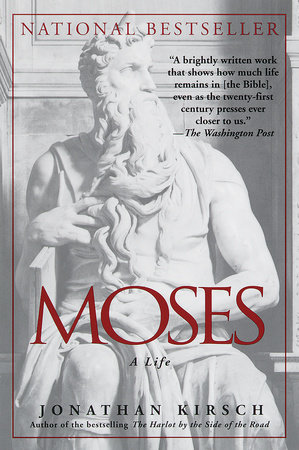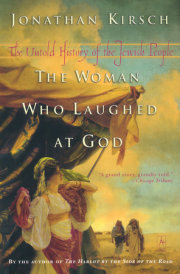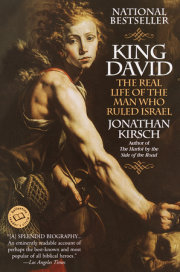Chapter One
THE MOSES NO ONE KNOWS
God answered, “While the light of truth is not in thee Thou hast no power to behold the mystery.”
Then Moses prayed, “O God, give me that light.…”
—JAMI, DIVINE JUSTICE
The Bible is remarkably blunt and plainspoken in telling the life story of Moses. Unlike the sacred writings and court histories of other figures from distant antiquity, which tend to dress up their heroes as saints, kings, and even gods, the Bible portrays Moses with brutal honesty and flesh-and-blood realism. Indeed, the essential impression of Moses that we are given in the Bible—and the real genius of his depiction at the hands of the biblical authors—is that he was born like every other infant, grew to manhood with all the impulses and excesses of which real men and women are capable, lived a life marked with passions that are perfectly human, and came to a tragic end that is no less riddled with ambiguity and contradiction than any other human life.
“There is nothing divine about Moses,” observes the eminent Bible scholar Gerhard von Rad,1 and, as if to remind us of this crucial fact, the Bible refers to him with a simple, sturdy, and straightforward phrase—“the man Moses.” (Exod. 32:1, 23; Num. 12:3)
Yet much of what we think we know about Moses is simply made up, and much of what the Bible does say about him is left out of both sacred and secular art. When they conjured up the visions of Moses that are so deeply familiar to us today, Renaissance artists and Hollywood moguls alike felt at liberty to make him over into a shimmering icon—the ultimate irony for the first iconoclast in recorded history. Even the learned theological commentaries and richly decorated sermons of the clergy tend to leave out the more scandalous incidents of his troubled and tumultuous life. Ironically, some of the most intriguing details to be found in the biblical account of Moses never find their way into art and literature, sermons and Sunday school lessons, and what is invented is often much less interesting than what has been left out. So we are left to wonder: Who, after all, is the real Moses?
As we shall discover in the pages that follow, Moses is the most haunted and haunting figure in all of the Bible. To be sure, he is often portrayed as strong, sure, and heroic, but he is also timid and tortured with self-doubt at key moments in his life. He is a shepherd, mild and meek, but he is also a ruthless warrior who is capable of blood-shaking acts of violence, a gentle teacher who is also a magician and a wonderworker, a lawgiver whose code of justice is merciful except when it comes to purging and punishing those who disagree with him, an emancipator who rules his people with unforgiving authority. Whatever he may have looked like—and the Bible never really tells us—the fact is that he hid a disfigured face behind a veil for the last forty years of his long life. He is God’s one and only friend, and yet he is doomed to a tragic death by God himself.
But as we shall soon see, the real Moses has been concealed from us, sometimes by subtle manipulation of the ancient text, sometimes by pointed silence and sins of omission, and sometimes by unapologetic censorship or outright lies, first by the priests and scribes who were the original authors and editors of the Bible, then by the preachers and teachers who were the guardians of the sacred text, and finally by the artists and bards who interpreted the Bible in works of art and literature. Devout tradition in both Judaism and Christianity has always felt obliged to portray Moses as unfailingly good and meek, dignified and devout, righteous and heroic—and that is why we do not hear much about the passages of Holy Writ in which Moses is shown to act in timid and even cowardly ways, throw temper tantrums, dabble in magic, carry out purges and inquisitions, conduct wars of extermination, and talk back to God. The real Moses—the Moses no one knows—was someone far richer and stranger than we are customarily allowed to see.
THE REAL MOSES
Two or three thousand years of art, theology, politics, and propaganda have turned Moses from a mortal man into a plaster saint. Among pulpit clergy and Bible critics alike, both Christians and Jews, Moses is hailed as Lawgiver, Liberator, and Leader, the prophet who bestowed upon Western civilization the Ten Commandments and the very idea of “ethical monotheism,” the hero who led the Israelites out of slavery in Egypt and delivered them to the portals of the Promised Land. According to Jewish tradition, he is Moshe Rabbenu (“Moses, Our Master”), a phrase that honors his role as “the greatest of all the Jewish teachers.”2 Christian theology regards Jesus as “the new Moses,” and the Gospel of Matthew depicts Moses as a ghostly witness to the transfiguration of Jesus atop a sacred mountain (Matt. 17:3). Islam, too, recognizes Moses as among its first and greatest prophets: the Koran characterizes Moses as the one who first predicted the coming of Mohammad, whom Muslims regard as an inheritor of the mantle of prophecy once worn by Moses and Jesus.
“And there arose not a prophet since in Israel like unto Moses,” enthused the author of the Book of Deuteronomy, “whom the Lord knew face to face.” (Deut. 34:10)*
So Moses tends to loom up as much larger than life. He was “the pattern prophet,”3 the first and greatest of the seers whose writings make up much of the Bible itself. He was regarded as the role model for earthly kings from David and Solomon to the more recent royals of Western Europe who claimed to rule by divine right. In both Jewish and Christian tradition he was thought to be the precursor of the Messiah, and the key moments in the life of Jesus are presented in the Gospels as a reenactment of the Moses story: Pharaoh’s death sentence on the firstborn of Israel predicts Herod’s slaughter of the innocents; the crossing of the Red Sea is understood by some Christian commentators as a symbolic baptism of the children of Israel; and the miracle of manna and quails anticipates the miracle of loaves and fishes.
The exalted and sanctified Moses has been a man for all seasons and every age. Ancient sages identified Moses as the inspiration for and counterpart of a whole pantheon of pagan gods, including the Egyptian scribal god Thoth and the Greek messenger god Hermes. Like these pagan deities, Moses was traditionally credited with the invention of the alphabet and the art of writing.4 Philo of Alexandria shoehorned Moses into the conventions of Hellenistic philosophy as “the epitome of ideal humanity”5 and “the best of all lawgivers in all countries.”
Fresh interest in Moses as a liberator flared up in the fires of the French Revolution, and the very same man who symbolized kingship to the ancien régime was claimed as a symbol of liberation by the oppressed people who sought to behead their king. African-Americans who were literally enslaved in the Land of the Free enshrined Moses in their folk culture as well as their churches: “Go down, Moses” can be seen as one of the earliest anthems of the civil rights movement in the United States. More recently, Moses has been brought fully into the New Age as “the true Empath,” in the words of essayist Ari Z. Zivotofsky, who invites us to regard Moses as a man who is “not only caring and concerned for others, but also … willing and ready to act upon those feelings.”
Moses was even appropriated by the worst enemies of the Jewish people in what must rank as the single most cynical use of a much abused biblical figure. During World War II, the Nazi bureaucracy that ran the machinery of the Holocaust printed up a supply of currency especially for use by the Jewish inmates of the “model” concentration camp at Terezin, a showplace that was operated for the benefit of inspectors from the International Red Cross, who were never allowed to see Auschwitz or Bergen-Belsen or Dachau. As if to taunt the doomed men, women, and children of Terezin with their own impotence, the image of Moses was imprinted on the concentration camp currency—and the Nazis chose a rendering of Moses that showed him at his most potent and militant.
No matter what political and theological agenda he is made to serve, Moses is usually presented as a purely ideal figure, always humble, mild, and righteous. Truth be told, however, the biblical Moses is seldom humble and never mild, and his conduct cannot always be regarded as righteous. At certain terrifying moments, as the Bible reveals to anyone who is willing to read it with open eyes, Moses rears up as arrogant, bloodthirsty, and cruel.
Copyright © 2009 by Jonathan Kirsch. All rights reserved. No part of this excerpt may be reproduced or reprinted without permission in writing from the publisher.










